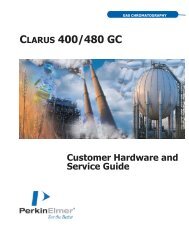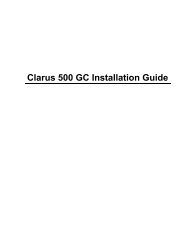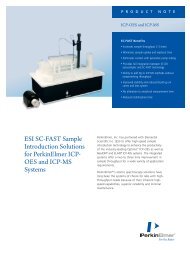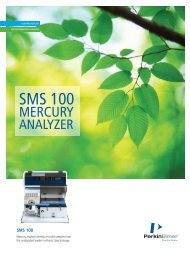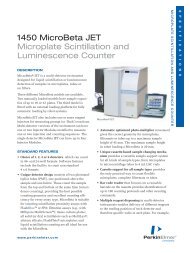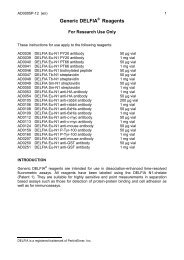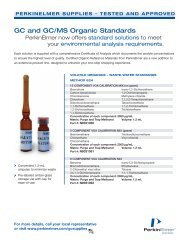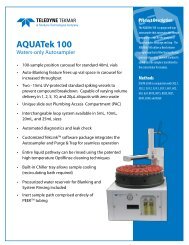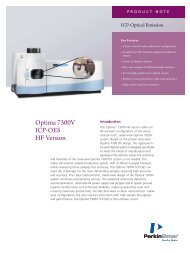HT Protein Charge Variant Kit User Guide - PerkinElmer
HT Protein Charge Variant Kit User Guide - PerkinElmer
HT Protein Charge Variant Kit User Guide - PerkinElmer
You also want an ePaper? Increase the reach of your titles
YUMPU automatically turns print PDFs into web optimized ePapers that Google loves.
<strong>HT</strong> <strong>Protein</strong> <strong>Charge</strong> <strong>Variant</strong> <strong>Kit</strong> <strong>User</strong> <strong>Guide</strong><br />
Assay Performance<br />
1. How does this assay compare to conventional IEC, CZE and cIEF?<br />
Typically, the resolution of the <strong>HT</strong> <strong>Protein</strong> <strong>Charge</strong> <strong>Variant</strong> assay is the same or higher than that of IEC.<br />
The resolution of the <strong>HT</strong> <strong>Protein</strong> <strong>Charge</strong> <strong>Variant</strong> assay is comparable to conventional CZE, and in<br />
most cases, the profile is similar to cIEF. The % Relative Amounts of variants reported by the <strong>HT</strong><br />
<strong>Protein</strong> <strong>Charge</strong> <strong>Variant</strong> assay are similar to those given by conventional assays. The analysis time of<br />
the <strong>HT</strong> <strong>Protein</strong> <strong>Charge</strong> <strong>Variant</strong> assay is typically 10- to 50-fold faster than that of conventional assays.<br />
2. Why does the electropherogram end 20 seconds before the time stated in the assay name?<br />
The next sample is sipped after the end of the separation of the current sample, for 20 seconds. During<br />
this time, no relevant data are collected and so these 20 seconds are excluded from the<br />
electropherogram. In the assay names, we have given the sum of the times required for the sip and the<br />
separation steps to provide the total time required to analyze each sample.<br />
3. Can I run multiple samples that have different pI at the same pH?<br />
It is possible to run multiple samples with varying pI at the same pH and achieve adequate resolution<br />
of charge variants for each sample. We recommend limiting the range of pI to no more than the ranges<br />
given in Table 2. However, even with this limit, the resolution for all samples may not be optimal.<br />
4. What should I do if I don’t know the pI of my sample?<br />
We suggest running the longest assay, using the running buffer at pH 5.6. Depending on the<br />
resolution, proceed with the optimization of the pH of the running buffer, as described in the<br />
Optimization of Running Buffer pH section.<br />
5. Can I use my own running buffer or modify the current running buffer?<br />
The Running Buffer provided in the kit has been optimized for resolution and reproducibility. We do not<br />
support the use of customer-developed running buffers.<br />
6. Once a chip is used for the <strong>HT</strong> <strong>Protein</strong> <strong>Charge</strong> <strong>Variant</strong> assay, can it be used for DNA/RNA<br />
assays, or vice versa?<br />
No. Once the chip has been used for the <strong>HT</strong> <strong>Protein</strong> <strong>Charge</strong> <strong>Variant</strong> assay, it should be designated for<br />
this assay only. Running other assays with the same chip will compromise the performance of the chip.<br />
DNA/RNA assays may still be run with the same chip.<br />
7. Can this assay be run on the LabChip 90?<br />
No. The LapChip 90 software does not support this assay.<br />
8. If I am encountering difficulties, how do I confirm that the kit is working properly?<br />
Amino acids such as lysine and histidine can be used as control samples, to check the labeling<br />
reaction and the chip. See Troubleshooting section.<br />
_________________________________________________________________________________________<br />
Caliper - a <strong>PerkinElmer</strong> Company Page 16 of 18 PN: CLS135474 Rev. 02<br />
68 Elm Street<br />
Hopkinton, MA 01748-1668<br />
1-877-LABCHIP (1-877-522-2447)



